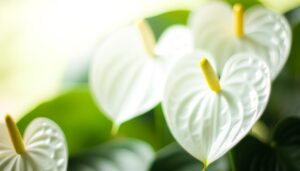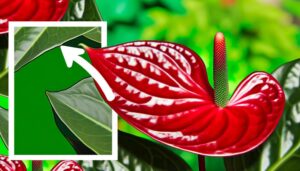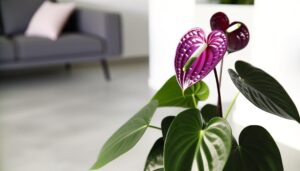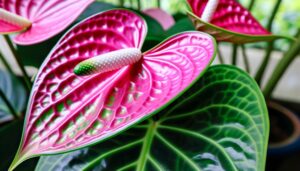Essential Care Tips for Your Anthurium Red Champion
To care for your Anthurium Red Champion, make sure it receives bright, indirect light and maintain a temperature between 65°F and 80°F. Use well-draining, nutrient-rich soil with a pH of 5.5 to 6.5, and water with lukewarm, distilled water.
Keep humidity levels between 70% and 80% using humidifiers or pebble trays. Repot every 1-2 years in a pot with adequate drainage, using a mix of orchid bark, perlite, and peat moss.
Monitor for pests and use neem oil as needed. Regularly inspect and rotate the plant for best growth.
For more advanced care practices, continue exploring.
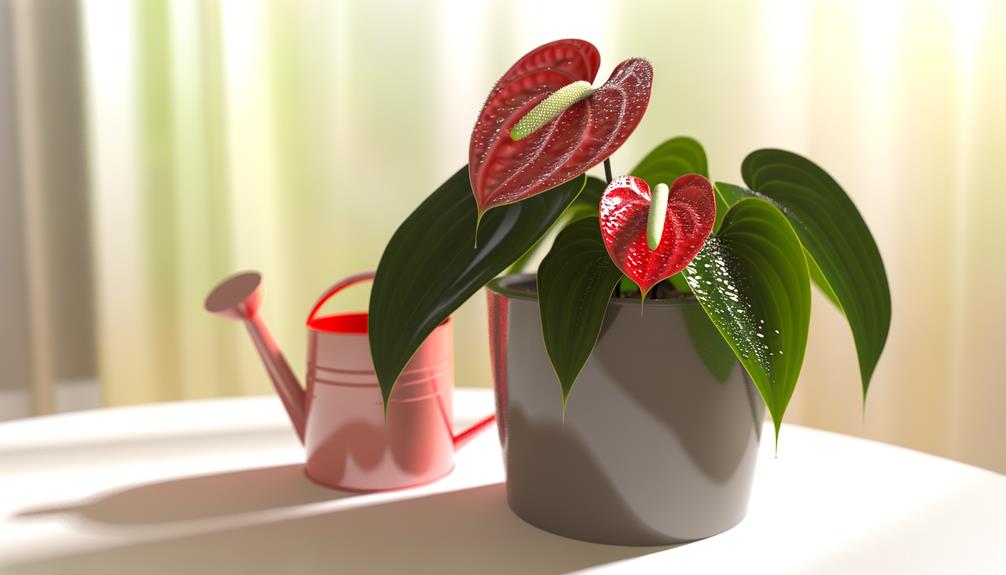
Key Takeaways
- Place your Anthurium Red Champion in bright, indirect sunlight to avoid leaf scorching and ensure uniform growth.
- Maintain soil moisture with well-draining potting mix, using lukewarm, distilled water, and adjust watering frequency based on growth phases.
- Keep the temperature between 65°F and 80°F to promote healthy root development and avoid temperature extremes.
- Maintain humidity levels between 70% and 80% using humidifiers or pebble trays and monitor with a hygrometer.
- Use a well-draining, nutrient-rich soil mix with a pH of 5.5 to 6.5 and repot every 1-2 years.
Watering Schedule
Anthurium Red Champion's watering schedule requires precise attention to soil moisture, ensuring it remains evenly damp but not waterlogged. You'll need to master the balance between hydration and aeration. Use a well-draining potting mix to prevent root rot.
Monitor soil moisture by inserting your finger about an inch deep; if it feels dry, it's time to water. Always use lukewarm, distilled water or rainwater to avoid mineral buildup. Water thoroughly until excess drains from the bottom, then discard any residual water in the saucer.
During active growth phases, typically spring and summer, increase watering frequency. In contrast, reduce it during dormancy in fall and winter. Consistent moisture levels will keep your Anthurium Red Champion thriving.
Light Requirements
Proper light conditions are essential for the best growth and vibrant blooms of your Anthurium Red Champion. Position it in a location where it receives bright, indirect sunlight. Direct sunlight can scorch its leaves, while insufficient light stunts growth and diminishes flower production. East or north-facing windows are ideal. If natural light is insufficient, use a grow light to mimic ideal conditions.
Guarantee the light source is steady; fluctuations can stress the plant. Rotate your Anthurium every few weeks to promote uniform growth. Remember, light intensity greatly impacts photosynthesis, directly influencing your plant's health.
Ideal Temperature
Maintaining an ideal temperature range between 65°F and 80°F is critical for the Anthurium Red Champion's health and vibrant blooms. This temperature spectrum mirrors its native tropical environment, guaranteeing peak metabolic activity and growth.
Avoid placing your Anthurium near drafts, air conditioning vents, or heaters, as fluctuations can stress the plant. Night temperatures shouldn't drop below 60°F, as cooler conditions can stunt growth and diminish flowering.
Consistent warmth supports root development and foliage resilience, enhancing overall vitality. Should you notice any signs of temperature stress, such as yellowing leaves or reduced flowering, promptly adjust the environmental conditions.
Precision in temperature control assures your Anthurium remains a stunning, thriving centerpiece.
Humidity Levels
Optimal humidity levels between 70% and 80% are necessary for the Anthurium Red Champion's physiological processes and overall vigor. High humidity promotes best transpiration, ensuring efficient nutrient uptake. You should consider using a humidifier or pebble tray to maintain these levels. Monitoring is essential; a hygrometer will provide precise measurements.
Here's a quick reference table for maintaining humidity:
| Humidity Level | Method | Frequency |
|---|---|---|
| 70% – 80% | Humidifier | Daily |
| 70% – 80% | Pebble Tray | Refill as needed |
| 70% – 80% | Misting | Twice a day |
Soil Preferences
Choosing the right soil mix is crucial for the Anthurium Red Champion, as it requires well-draining, nutrient-rich substrates to thrive. You'll want to create a blend that provides ample aeration while retaining necessary moisture.
Incorporate orchid bark, perlite, and peat moss in equal parts. This combination ensures ideal drainage and prevents root rot, a common issue with dense soils. Additionally, a pH level of 5.5 to 6.5 is recommended, as it allows for efficient nutrient uptake.
Regularly check the soil's texture; it should remain loose and airy. Avoid dense garden soils or those with poor drainage. By carefully crafting the perfect soil mix, you'll promote a healthy root system and lush foliage for your Anthurium Red Champion.
Fertilizing Needs
Consistently providing well-balanced, slow-release fertilizers assures your Anthurium Red Champion receives the necessary nutrients for optimal growth. Apply a 20-20-20 formula every six to eight weeks during the growing season. Confirm the fertilizer is diluted to half-strength to prevent root burn.
Micronutrients like iron, magnesium, and calcium are vital for vibrant foliage and strong blooms. Avoid high phosphorus fertilizers as they can hinder uptake of other necessary nutrients.
Monitor your plant's response closely; yellowing leaves may indicate nutrient deficiencies, requiring adjustments. Always water your Anthurium before applying fertilizer to minimize root damage. Organic options like fish emulsion or worm castings can also improve soil health.
Thorough fertilization, tailored to your plant's specific requirements, nurtures a flourishing Anthurium Red Champion.
Pruning Techniques
Pruning your Anthurium Red Champion involves removing dead or yellowing leaves and spent flowers to promote healthier growth and more vibrant blooms. Here's how to prune effectively:
- Sanitize Tools:
Use sterilized pruning shears to avoid introducing pathogens.
- Identify Targets:
Locate leaves that are discolored or wilted, and flowers that have finished blooming.
- Clean Cuts:
Make precise cuts close to the base, avoiding damage to nearby healthy tissue.
- Frequency:
Conduct pruning every few weeks or as needed to maintain plant well-being.
Pest Control
When managing pest control for your Anthurium Red Champion, you'll need to identify common pests like aphids, spider mites, and mealybugs. Utilize natural repellents such as neem oil and insecticidal soap to tackle infestations effectively.
Implement preventive maintenance practices, including regular inspections and proper humidity control, to maintain a healthy plant environment.
Common Pests Identification
Identifying common pests such as aphids, spider mites, and mealybugs early on is essential for effective pest control in Anthurium Red Champion plants. You'll need to inspect your plant regularly. Look closely at the undersides of leaves and stems where these pests typically hide. Here are the key signs:
- Aphids: Tiny, pear-shaped insects that cluster on new growth, secreting a sticky substance known as honeydew.
- Spider Mites: Minuscule, often red or white pests that produce fine webbing and cause speckled discoloration on leaves.
- Mealybugs: White, cotton-like masses often found in leaf axils and along stems, causing stunted growth.
- Thrips: Slender insects that scrape leaf surfaces, leaving silvery streaks and black specks of excrement.
Be vigilant and address infestations promptly.
Natural Repellent Solutions
Implementing natural repellent solutions can effectively manage pests on your Anthurium Red Champion without resorting to harsh chemicals. Utilize neem oil, a potent yet gentle biopesticide, by mixing 2 teaspoons with a quart of water. Spray this solution directly on the leaves. Additionally, introduce garlic spray—created by blending garlic cloves with water—as a robust deterrent against spider mites. Consider diatomaceous earth; its abrasive nature disrupts insect exoskeletons, rendering them inactive. Apply a thin layer on the soil's surface.
| Natural Repellent | Preparation Method | Application Instructions |
|---|---|---|
| Neem Oil | 2 tsp in 1 quart of water | Spray directly on leaves |
| Garlic Spray | Blend garlic with water | Apply to affected areas |
| Diatomaceous Earth | Sprinkle on soil | Thin layer on soil's surface |
These methods ensure your Anthurium thrives pest-free.
Preventive Maintenance Practices
Regularly examining your Anthurium Red Champion for early signs of pest infestation is crucial for maintaining its health and vigor. When it comes to pest control, vigilance is paramount. Start with a consistent inspection routine to identify potential threats early.
Follow these steps to safeguard your plant remains pest-free:
- Inspect leaves and stems: Look for discolorations, holes, or sticky residues, which indicate pests like aphids or spider mites.
- Check soil moisture: Excessive soil moisture can attract fungus gnats; guarantee proper drainage.
- Utilize neem oil: Apply a diluted neem oil solution bi-weekly to deter common pests.
- Isolate new plants: Quarantine any new additions to your collection to prevent cross-contamination.
Repotting Guidelines
To guarantee your Anthurium Red Champion thrives, you must focus on selecting the right pot, utilizing the best soil mix, and adhering to proper repotting frequency.
Select a pot with sufficient drainage to prevent root rot, and choose a soil mix that offers excellent aeration and moisture retention.
Repot every 2-3 years to accommodate growth and refresh the soil medium.
Choosing the Right Pot
When repotting your Anthurium Red Champion, it's important to select a pot with sufficient drainage and a size that allows for proper root expansion. This guarantees ideal growth and health.
Consider the following:
- Material: Use terracotta or ceramic pots for improved moisture regulation.
- Size: Choose a pot that's 1-2 inches larger in diameter than the current one to avoid root-bound conditions.
- Drainage Holes: Ensure multiple drainage holes to avoid waterlogging and root rot.
- Shape: Opt for a slightly deeper pot to accommodate the root system's vertical growth.
Best Soil Mix
Selecting the right pot is only half the battle; a perfect soil mix that balances aeration, moisture retention, and nutrient content is paramount for your Anthurium Red Champion's health.
Aim for a mix comprising equal parts orchid bark, perlite, and peat moss. Orchid bark provides necessary aeration, ensuring roots breathe freely. Perlite maintains moisture without waterlogging, preventing root rot. Peat moss delivers essential nutrients while retaining moisture.
Avoid heavy soils or those inclined to compact, as they restrict root growth and hinder nutrient uptake. Incorporate slow-release fertilizer or a balanced, water-soluble fertilizer to enhance nutrient availability.
Repotting Frequency
Repotting your Anthurium Red Champion every 1-2 years guarantees peak root health and growth potential. To ensure best growth, follow these precise steps:
- Select the Right Pot: Choose a container that's 1-2 inches larger in diameter than the current one. This provides ample space for root expansion without overwhelming the plant.
- Use Fresh Soil Mix: Opt for a well-draining, aerated substrate, rich in organic matter. Avoid compact soils that can suffocate the roots.
- Gently Remove the Plant: Carefully loosen the root ball to avoid damaging delicate roots. Inspect for root rot and trim any affected areas.
- Replant and Water: Position the Anthurium at the same depth it was previously planted. Water thoroughly to settle the new soil around the roots.
Propagation Methods
To propagate Anthurium Red Champion, utilize the division method by carefully separating the root clumps during repotting. Begin by gently removing the plant from its pot, guaranteeing minimal disturbance to the roots.
Identify naturally formed offsets or smaller clumps, and use a sterilized knife to cleanly cut through the rhizomes, making sure each division has sufficient roots and foliage. Replant the divisions in well-draining, orchid-based potting mix, and water sparingly until new growth emerges. Maintain high humidity and indirect light to encourage successful establishment.
Avoid overwatering to prevent root rot. This method secures genetic consistency and robust growth. Propagation through division is ideal for maintaining the plant's health and enhancing your collection with minimal risk.
Common Problems
Despite its hardy nature, the Anthurium Red Champion can still encounter several common problems that may hinder its growth and overall health. Recognizing these issues early will allow you to take corrective measures promptly.
- Yellowing Leaves: Often caused by overwatering or poor drainage, leading to root rot. Make sure that the soil is well-draining and that you allow the top inch to dry out before watering again.
- Brown Leaf Tips: Typically a sign of low humidity or insufficient watering. Increase the ambient humidity using a humidifier or a pebble tray.
- Pest Infestations: Spider mites, aphids, and mealybugs can attack the plant. Regularly inspect the foliage and use insecticidal soap or neem oil as needed.
- Lack of Blooms: Insufficient light or nutrients can reduce flowering. Position your plant in bright, indirect light and provide a balanced fertilizer monthly.
Seasonal Care
To maintain peak health for your Anthurium Red Champion, adjust care routines seasonally.
In winter, reduce watering frequency to prevent root rot.
Come spring, initiate a balanced fertilization regimen.
In summer, guarantee the plant receives indirect sunlight to avoid leaf scorch.
Winter Watering Routine
During winter, it's crucial to adjust your Anthurium Red Champion's watering frequency to prevent root rot and encourage optimal growth. The plant's growth rate slows down, requiring a precise approach to hydration. Here's a detailed guide:
- Reduce Frequency: Water your Anthurium every 10-14 days, allowing the top inch of soil to dry out completely.
- Check Humidity: Maintain relative humidity around 60-70% to offset reduced watering.
- Water Quality: Use distilled or rainwater to prevent mineral build-up.
- Temperature Monitoring: Guarantee your plant stays in a stable environment between 65-75°F, avoiding drafts.
Spring Fertilization Tips
As winter wanes and growth rates increase, it's time to enrich your Anthurium Red Champion with a balanced plant food to support vigorous spring development. Choose a high-quality, water-soluble fertilizer with equal parts nitrogen, phosphorus, and potassium (20-20-20) for best nutrient uptake.
Dilute the fertilizer to half strength to avoid root burn and apply bi-weekly during the active growing season. Maintain the soil's moisture levels but avoid waterlogging to facilitate nutrient absorption. Monitor the plant's response; lush, green leaves indicate proper feeding.
If yellowing occurs, reduce the fertilizer frequency. Remember, moderation is key. Overfeeding can lead to nutrient toxicity, compromising plant health. By following these guidelines, you'll promote strong growth and vibrant blooms in your Anthurium Red Champion.
Summer Sunlight Needs
Your Anthurium Red Champion thrives under bright, indirect light, making it essential to shield the plant from harsh, direct summer sunlight to prevent leaf scorch. Follow these precise steps to ensure optimal sunlight exposure:
- Positioning: Place your Anthurium near an east or north-facing window where it receives filtered sunlight.
- Shielding: Use sheer curtains or blinds to diffuse intense sunlight, mimicking its native habitat.
- Rotation: Rotate the plant weekly to guarantee even light distribution and balanced growth.
- Monitoring: Regularly inspect leaves for signs of sunburn—yellowing or browning edges—and adjust positioning as necessary.
Conclusion
Caring for your Anthurium Red Champion doesn't have to be overwhelming. With precise watering, ideal light, and proper temperature, you'll promote its perennial beauty.
Humidity helps, so keep it high. Soil should be well-draining, and repot when roots need space. Prolific propagation and problem prevention will guarantee plant prosperity.
Remember, seasonal changes require subtle adjustments. Stick to these strategies, and your Anthurium will thrive, displaying its striking scarlet splendor.

